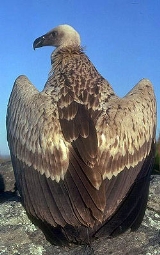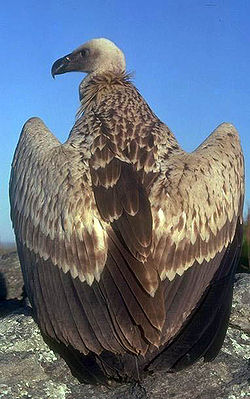
Cape Vulture
Encyclopedia
The Cape Griffon or Cape Vulture (Gyps coprotheres), also known as Kolbe's Vulture, is an Old World vulture
in the family Accipitridae
, which also includes eagle
s, kite
s, buzzard
s and hawk
s. It is endemic to southern Africa
, and is found mainly in South Africa
, Lesotho
, Botswana
and in some parts of northern Namibia. It nests on cliffs and lays one egg per year.
 This vulture is dark brown except for the pale wing coverts. The adult is paler than the juvenile, and its underwing coverts can appear almost white at a distance. The average length is about 96–115 cm (37.8–45.3 in) with a wingspan of 2.26–2.6 m (7.4–8.5 ft) and a body weight of 7–11 kg (15.4–24.3 lb). They are on average the largest raptor
This vulture is dark brown except for the pale wing coverts. The adult is paler than the juvenile, and its underwing coverts can appear almost white at a distance. The average length is about 96–115 cm (37.8–45.3 in) with a wingspan of 2.26–2.6 m (7.4–8.5 ft) and a body weight of 7–11 kg (15.4–24.3 lb). They are on average the largest raptor
in Africa
, although they are subservient to the powerful Lappet-faced Vulture
. The two prominent bare skin patches at the base of the neck, also found in the White-backed Vulture
, are thought to be temperature sensors and used for detecting the presence of thermals.
The species is listed by the IUCN as "Vulnerable", the major problems it faces being poisoning, disturbance at breeding colonies and powerline electrocution. The current population is estimated at 8,000.
Old World vulture
Old World vultures belong to the family Accipitridae, which also includes eagles, buzzards, kites, and hawks.Old World vultures are not closely related to the superficially similar New World vultures and condors, and do not share that group's good sense of smell. The similarities between the two...
in the family Accipitridae
Accipitridae
The Accipitridae, one of the two major families within the order Accipitriformes , are a family of small to large birds with strongly hooked bills and variable morphology based on diet. They feed on a range of prey items from insects to medium-sized mammals, with a number feeding on carrion and a...
, which also includes eagle
Eagle
Eagles are members of the bird family Accipitridae, and belong to several genera which are not necessarily closely related to each other. Most of the more than 60 species occur in Eurasia and Africa. Outside this area, just two species can be found in the United States and Canada, nine more in...
s, kite
Kite (bird)
Kites are raptors with long wings and weak legs which spend a great deal of time soaring. Most feed mainly on carrion but some take various amounts of live prey.They are birds of prey which, along with hawks and eagles, are from the family Accipitridae....
s, buzzard
Buzzard
A buzzard is one of several large birds, but there are a number of meanings as detailed below.-Old World:In the Old World Buzzard can mean:* One of several medium-sized, wide-ranging raptors with a robust body and broad wings....
s and hawk
Hawk
The term hawk can be used in several ways:* In strict usage in Australia and Africa, to mean any of the species in the subfamily Accipitrinae, which comprises the genera Accipiter, Micronisus, Melierax, Urotriorchis and Megatriorchis. The large and widespread Accipiter genus includes goshawks,...
s. It is endemic to southern Africa
Southern Africa
Southern Africa is the southernmost region of the African continent, variably defined by geography or geopolitics. Within the region are numerous territories, including the Republic of South Africa ; nowadays, the simpler term South Africa is generally reserved for the country in English.-UN...
, and is found mainly in South Africa
South Africa
The Republic of South Africa is a country in southern Africa. Located at the southern tip of Africa, it is divided into nine provinces, with of coastline on the Atlantic and Indian oceans...
, Lesotho
Lesotho
Lesotho , officially the Kingdom of Lesotho, is a landlocked country and enclave, surrounded by the Republic of South Africa. It is just over in size with a population of approximately 2,067,000. Its capital and largest city is Maseru. Lesotho is a member of the Commonwealth of Nations. The name...
, Botswana
Botswana
Botswana, officially the Republic of Botswana , is a landlocked country located in Southern Africa. The citizens are referred to as "Batswana" . Formerly the British protectorate of Bechuanaland, Botswana adopted its new name after becoming independent within the Commonwealth on 30 September 1966...
and in some parts of northern Namibia. It nests on cliffs and lays one egg per year.

Bird of prey
Birds of prey are birds that hunt for food primarily on the wing, using their keen senses, especially vision. They are defined as birds that primarily hunt vertebrates, including other birds. Their talons and beaks tend to be relatively large, powerful and adapted for tearing and/or piercing flesh....
in Africa
Africa
Africa is the world's second largest and second most populous continent, after Asia. At about 30.2 million km² including adjacent islands, it covers 6% of the Earth's total surface area and 20.4% of the total land area...
, although they are subservient to the powerful Lappet-faced Vulture
Lappet-faced Vulture
The Lappet-faced Vulture or Nubian Vulture is a mostly African Old World vulture belonging to the bird order Accipitriformes, which also includes eagles, kites, buzzards and hawks. It is the only member of the genus Torgos. A distinct subspecies T. t. negevensis occurs in the Sinai, the Negev...
. The two prominent bare skin patches at the base of the neck, also found in the White-backed Vulture
White-backed Vulture
The White-backed Vulture is an Old World vulture in the family Accipitridae, which also includes eagles, kites, buzzards and hawks. It is closely related to the European Griffon Vulture, G. fulvus...
, are thought to be temperature sensors and used for detecting the presence of thermals.
The species is listed by the IUCN as "Vulnerable", the major problems it faces being poisoning, disturbance at breeding colonies and powerline electrocution. The current population is estimated at 8,000.

